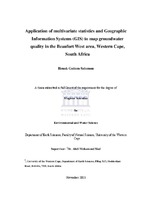| dc.description.abstract | Groundwater in arid and semi-arid areas like the Karoo region of South Africa is an important source of domestic, agricultural and industrial source of fresh water. As a scarce resource, it requires extensive quality control and protection through innovative methods and efficient strategies. The town of Beaufort West and its vicinity use groundwater as a major source of municipal and private water supply. Forty nine groundwater samples were collected from spatially referenced boreholes located in and around the town of Beaufort West and were analyzed for EC, pH, TDS,TH, SAR, TA, Ca2+, Mg2+, Na+, K+, HCO3-, Cl-, NO3- and SO42- according to SANS 241 standards and tested for ionic balance. The groundwater of the study area was characterized using WHO and South African drinking water quality standards as well as TDS and Salinity hazard classifications. These comparisons and classifications characterized the groundwater of the study area as hard to very hard, with low to medium salinity hazard. These results are in accordance with the dominance of the ions Ca2+, Na+, HCO3 - and Cl- in the groundwater samples. Linear relationships between the hydrochemical variables were analysed through correlation and multiple regression analysis to relate the groundwater quality to the underlying hydrogeochemical processes. These linear relationships explained the contribution of the measured variables towards the salinity, hardness and anthropogenic contamination of the groundwater. The groundwater of the study area was also assessed using conventional trilinear diagrams and scatter plots to interpret the water quality and determine the major ion chemistry. The conventional methods highlighted the sources of the hydrochemical variables through analysis and interpretation of rock-water interaction and evaporations processes. To supplement these conventional methods and reveal hidden hydrogeochemical phenomenon, multivariate statistical analyses were employed. Factor analysis reduced the hydrochemical variables into three factors (Hardness, Alkalinity and Landuse) that characterize the groundwater quality in relation to the source of its hydrochemistry. Furthermore, combination of Cluster (CA) and Discriminant analyses (DA) were used to classify the groundwater in to different hydrochemical facies and determine the dominant hydrochemical variables that characterize these facies. The classification results were also compared with the trilinear diagrammatic interpretations to highlight the advantages of these multivariate statistical methods. The CA and DA classifications resulted in to six different hydrochemical facies that are characterized by NO3 -, Na+ and pH. These three hydrochemical variables explain 93.9% of the differences between the water types and highlight the influence of natural hydrogeochemical and anthropogenic processes on the groundwater quality. All the univariate, bivariate, multivariate statistical and conventional hydrogeochemical analyses results were analyzed spatially using ArcGIS 10.0. The spatial analysis employed the Inverse Distance Weighted (IDW) interpolation method to predict spatial distribution of unmeasured areas and reclassification of the interpolation results for classification purposes. The results of the different analyses methods employed in the thesis illustrate that the groundwater in the study area is generally hard but permissible in the absence of better alternative water source and useful for irrigation. | en_US |

